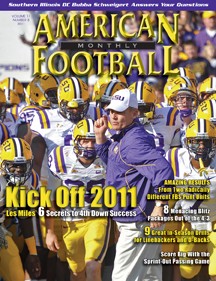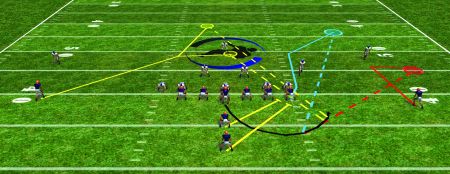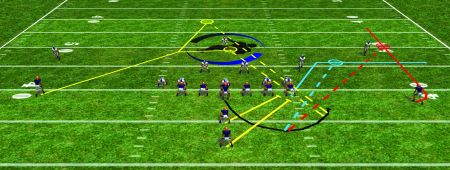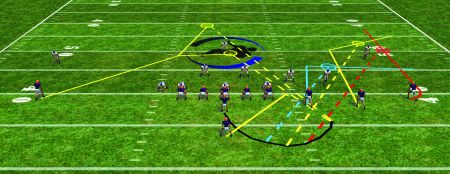Article CategoriesAFM Magazine
|
The Sprint-Out Passing Game: The Major Pass Routes – Reading the cornerback is critical to the success of the sprint-out passing game.by: Dale AndersonHead Coach, Southwest High School (KY) © More from this issue There are three major routes we use with the sprint-out game. These routes can be used against any coverage and the quarterback reads are all very simple. The sprint-out game is a timing type of passing game. The quarterback will sprint-out and attack the edge of the defense and must be ready to throw the football on his forth or fifth step. This will time with the breaks of the receivers, and the pass must be in the air before the break by the receiver. As with all passes, the quarterback will read the defensive coverage and the defense’s reaction to the pass routes. The quarterback will then determine his best available option. Since the success of the pass is based on timing, the quarterback reads must be simple and his decisions must be made quickly. The quarterback will start his reads before the snap. His reads will be like most QB pre-snap reads starting with the safety area. He will determine pre-snap if the coverage is a single or double safety before the snap. The quarterback’s most important read will occur on his first step away from the center after the snap. His eyes will focus on the defensive cornerback to the sprint side at the snap. As he takes his first three steps, the quarterback will read the reaction of that cornerback. If he reads the cornerback is backing out, the quarterback will hit the short route. If the cornerback sits in the flat, the quarterback will throw to his deep option. He also has a third option that can be a huge play for the offense. The backside read route can take advantage of a safety that rolls too quickly to the sprint-out side. The backside receiver will read the safety. If the safety rolls to the sprint-out side, the backside receiver breaks to the post behind him. If the safety backs up, the backside receiver will flatten his route under the safety and come across the field behind the linebackers. The third option can be thrown as the quarterback attacks downhill on the perimeter of the defense. If the quarterback feels that all the routes have been covered, he will run the ball and attack the defense with the run. It’s a good idea to explain to the quarterback that he needs to have the football up in a passing position to keep the defenders back as he starts to run the ball. It will take some practice to make these quick decisions but he really only has one read. It’s a quick passing game and the QB must make quick decisions to be successful.
Diagram 1 The first route we use is the Square Route (See Diagram 1). The Square is paired with a Flag Route. The outside receiver will run a true Square route. He will attack the inside shoulder of the cornerback and at six yards will make a hard break to the sideline. It is important that the receiver gets his head around and his hands up to prepare to catch the ball. The quarterback will be throwing the ball before the break occurs so the receiver must be ready. One common mistake by the receiver on the Square Route is to float deeper on his break. A good defender will be able to cut in front of this route if he floats deeper and make the interception or at least knock it down. If the ball is thrown on time and the route is run correctly, then it is a high percentage and safe route. On deep routes, we pair the Square Route with the Flag Route. The inside or #2 receiver will run the Flag Route. We tell the #2 receiver to get a quick release and attack straight upfield for 10 yards and then break on a 45-degree angle toward the sideline. Again, as soon as the receiver makes his break, he needs to get his eyes on the QB and his hands up to be ready to catch the ball. If he is running this route against a cover 2 safety, the #2 receiver will flatten out his flag route to stay away from the safety and keep him on the back hip.
Diagram 2. The second route we have is the Fade Route with a Square by the #2 receiver (See Diagram 2). This route is run with the #1 or outside receiver running a Fade Route and the #2 receiver running a Square Route. The #1 receiver will take a quick release outside and get upfield quickly. As the #1 receiver gets vertical, he must start to look for the football and get his hands ready to catch the ball. The quarterback will throw the ball in the hole for the fade route. It should be thrown between 10-16 yards deep. It should be thrown behind a cover 2 corner and before the safety can get over the top. The #2 receiver will release upfield for 6 yards and run a square route. He must break hard on the square and get separation from the defender. Again, it’s important that the #2 get his head around on his break and get his hands up to be ready to catch the ball. The quarterback is again reading the cornerback. If the corner backs up at all, the quarterback will hit the square underneath by the #2 receiver. If the corner sits, he will hit the fade in the hole. Again, if the first two options are covered, have the quarterback attack downhill and look for the backside read route. If these options are covered, then the quarterback still has the option to run the ball against the perimeter of the defense.
Diagram 3. The third route is a unique route we use that is a play off the Curl-Flat Routes. We call this the Route Circle-X (See Diagram 3). The #1 or outside receiver will run what we call a circle route and the #2 receiver will run the X route. On the circle route, the #1 receiver will outside release hard (like he is on the fade route) and then the receiver will circle inside at about 12 yards deep and then square up his shoulders to the quarterback and sit down in the window at about 10 yards. If the window closes, the receiver will work inside or outside until he finds an open window between himself and the quarterback. The #2 receiver will run an X route. He will step upfield two yards and then run a hard square (turning his head and flashing his hands for a quick square throw by the QB). The #2 receiver will continue the square until he crosses the release of the #1 receiver. At that point, the #2 receiver will flip his hips upfield and attack down the sideline. The #2 receiver must get his eyes on the QB and get his hands up because the quarterback is taught to throw the X route in the hole (10-16 yards deep on the sideline). The quarterback must throw this route on a rope and not lob the ball to the X receiver. Again, we are reading the corner on this route. If the corner backs out we will look at the circle. If the corner sits in the flat, we look at the circle. Again, if the first two options are covered have the quarterback attack downhill and look for the backside read route. If these options are covered, then the quarterback still has the option to run the ball against the perimeter of the defense. There are multiple routes you can run with the sprint-out game. These are the base routes we use. Obviously you can sprint out to a single receiver away from your formation. We have some good one-man routes to the weak side and we also can put a back out with the one receiver to attack a defense that is heavy to our two-receiver side (See Diagrams 4 and 5).
Diagram 4.
Diagram 5. We also have the ability to put three receivers out with the sprint- out passing game. You can either leak one of the backs out of the backfield or you can line up in multiple trips looks and flood the perimeter of the defense. Our favorite three-receiver route in the sprint-out game is with the #1 receiver running the Fade route, the #2 receiver running the Flag route and the #3 receiver running the Square route (See Diagram 6). This has been very effective for us through the years.
Diagram 6. We have used the sprint-out passing game in all types of offensive formations and schemes. It can be used with two backs and the quarterback under center. It can also be used with the QB in shotgun. It even can be used with the Pistol and with an empty set backfield. The sprint-out game from the shotgun or pistol becomes a very quick passing game and the threat of a quarterback run puts even more pressure on the defense. |
|
| HOME |
MAGAZINE |
SUBSCRIBE | ONLINE COLUMNISTS | COACHING VIDEOS |
Copyright 2024, AmericanFootballMonthly.com
All Rights Reserved










